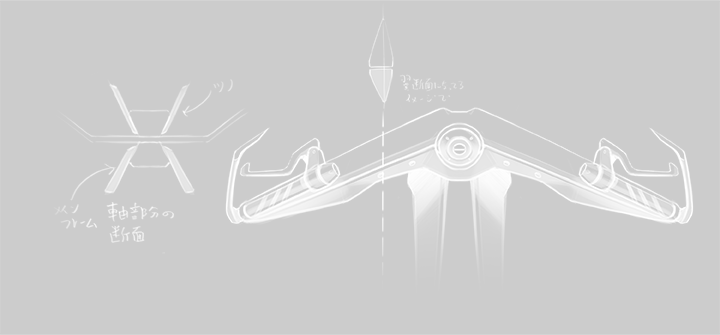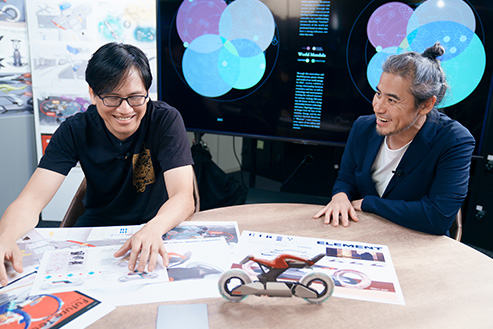TALK SESSION : Yamaha Motor
Yamaha Motor's design team plays a pivotal role in conceptualizing the futuristic world of 'Tokyo Override,' contributing their expertise to design the concept of the motorcycles that race through Tokyo, 100 years into the future!




Yamaha Motor's design team designs the world of the Netflix Series ‘Tokyo Override’. A special behind the scenes talk session! What role will motorbikes play 100 years from now? The appeal of world-building from the perspective of four key people of the project team.
-

Yuske Fukada
‘Tokyo Override’
Director, Producer -

Laura Cechanowicz
Golden Ticket Futures, ‘Tokyo Override’
World Designer, Worldbuilding Producer
Assistant Professor, Arizona State University -

Veerapatra Jinanavin
RiFF Studio
‘Tokyo Override’ Director -

Satoshi Nakamura
Yamaha Motor Co., Ltd.
Innovation Design Group
Planning Design Division

In an innovative collaboration, Yamaha has joined forces with Netflix to push the boundaries of animated storytelling. Tokyo Override is a fast-paced animation in which motorcycles are depicted as more than mere vehicles—they’re integral elements of culture and human experience. The film is the result of a shared vision for a futuristic world that has brought together the motorcycle expertise of the Yamaha Motor design team with animation directors and production designers from Japan, the US, and Thailand.










This project began when a team at Netflix approached director Yuske Fukada with a bare seed of an idea: a futuristic world with motorcycles at its heart. While the core concept involved mobility, many of the details were still undefined. Fukada saw this as an opportunity to embrace the creative process of worldbuilding and brought in the US based designer and worldbuilder Laura Cechanowicz to lead with her unique methodology, which creates an innovative ecosystem that transcends traditional filmmaking by merging it with a narrative-driven design process.
“I always wanted to try worldbuilding for a feature or series,” explains Fukada. “It’s a way to evolve concepts and create something coherent, new, and meaningful. So I was excited to be a part of this project from the early stages.”
Following the initial pitches with Fukada and Cechanowicz, the team at Netflix then approached Yamaha to ask the company if they could lend their expertise with motorcycles to the project and to make suggestions for which kind of bikes would feature in the series. “But as the conversation progressed,” Satoshi Nakamura from Yamaha recalls, “we learned about Cechanowicz’s process of worldbuilding, and it sounded fascinating. We at Yamaha are always thinking about innovative ideas for the future, but worldbuilding is beyond the usual scope of motorcycle manufacturing, so we were really interested in joining this project.” Nakamura felt that instead of simply providing vehicle designs and creating futuristic motorcycle concept models, the team could learn to expand its design methodology to go beyond meeting users’ needs and delve into the complicated process of exploring the world and its systems behind the user.
Fukada, Cechanowicz, and Yamaha then fortified their team through Cechanowicz’s company Golden Ticket Futures, pulling in experts and worldbuilders, and Thailand-based animation director Veerapatra Jinanavin—with his team at RiFF Studio—to lay the foundations for the project.


Nakamura shares his excitement about the chance to step beyond the boundaries of his usual work, “This project let us take a step further and imagine the systems behind the innovations we work hard to develop. It wasn’t just about creating bikes for the future but about envisioning an entire world that supports and interacts with them.” Nakamura was aware that this new world should consider not only infrastructure but also societal, cultural, and technological norms—creating a believable future city that’s both coherent and captivating for the audience.

To fully understand things from the perspectives of the individuals within the world of Tokyo Override, Cechanowicz led research projects to interview real-life people and get unique insights that would help them with the worldbuilding process. One example interviewee was a Yamaha employee who races bikes in his spare time. “We talked to him about his whole experience of riding, what it’s like to be on a bike.” Cechanowicz recounts, “That helped us understand the embodied perspective of a person in the world and why these bikes matter and what they mean to people.” The team incorporated these insights and stories into the systems of the world they were building.


an approach that brings people together. Tokyo Override was a union of ideas and strategies from Japan, Thailand, and the U.S., each perspective bringing a distinct cultural angle. “Having the process of worldbuilding from the start of this project really brought a cohesion between all of us, even though we were all from different backgrounds,” Cechanowicz recalls.
This mix of viewpoints was very refreshing for Veerapatra Jinanavin, whose Thailand-based animation agency RiFF Studio played a central role in the production. “Worldbuilding is like working as one team on a jigsaw puzzle, creating connections to ensure every aspect has a place and purpose within the story.” He remarks, joking that the 400-page concept the team created together felt like a Bible. “When I showed this 400-page book to my team, some people asked if they were required to become citizens of this world that we had created.” It’s a testament to how, through the worldbuilding process, the team had already painted a vivid, realistic future Tokyo before any animation work had even begun.


However, Yamaha’s role in the project went beyond simply showcasing motorcycles; the team aimed to explore how these vehicles could integrate meaningfully into a futuristic society. This included examining the philosophical question of human-machine coexistence, particularly in the age of artificial intelligence.
One of the key elements in Tokyo Override is a high-speed race, where AI and human riders compete side by side. Nakamura shares, “In today’s world, racing serves as both a technological proving ground and a test of human endurance. But in this imagined future, we had to rethink those motives. Why would humans still race 100 years from now? How would AI have influenced this?”



There were a lot of conversations among the team about the evolution of races 100 years into the future and how these races would transform the city itself. Several exciting ideas came about from these discussions, including how the city’s roads could physically move to adapt to the races. One topic was the relationship between the audience and the racers and whether spectators would be cheering on the AI technology or the humans racing in competition with the AI. It was also discussed that the nature of pit stops in the future would have evolved into more of a social event, where riders have the chance to interact with the fans, adding a layer of entertainment that blurs the line between sport and spectacle.





Cechanowicz adds that although worldbuilding may be a great way to build stories, it is also a method to develop real visions for the future that can be put into practice and business plans. She reflected on how this one shared future world also produced varying outcomes depending on each company’s expertise, Riff animating the TV series, and Yamaha building a virtual and physical speculative motorcycle. “I have extreme gratitude for the Yamaha team for being remarkably professional collaborators, particularly in the always tricky and intense first period of the planning.”

Through extensive research, cultural integration, groundbreaking creativity, and Yamaha’s innovative insights, this collaboration has produced an animation that redefines the concept of worldbuilding. Together, the team has crafted something remarkable: a world that feels authentic, engaging, and alive. For creators and viewers alike, Tokyo Override embodies the power of imagination, collaboration, and the future of storytelling, presenting a vision where technology, humanity, and mobility harmonize seamlessly.


'Tokyo Override' is now streaming on Netflix




